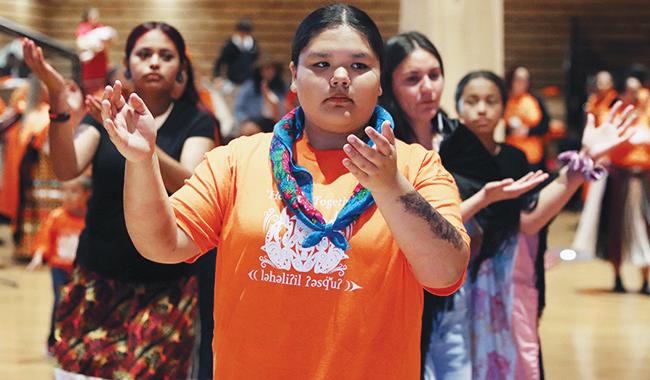
By Kalvin Valdillez, Tulalip News
“We were banned from having gatherings just like this one,” said Tulalip Youth Council member, Ariel Valencia. “My grandma on my mother’s side went to a boarding school located in Canada where she was beat almost hourly. She was stabbed in the chest with a knitting needle and got left with no medical help. She still has a scar to this day. That not only shows that we have generational trauma, but we still have memories of these schools, and not good ones either. And now, we are not going to hide our culture, our languages, our songs and dances, our voices. We’re going to thrive as Indigenous People and decolonize as much as we can because that’s what our ancestors would’ve wanted.”
It was a heavy night of raw emotions as the Tulalip community took time to address a hurt that many Natives carry with us. A heartbreak that was unintentionally passed down from our family members who attended boarding schools as kids. A suffering that boarding school survivors still live with today.
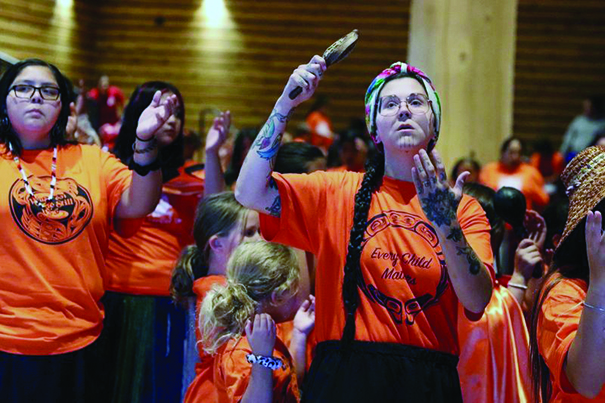
September 30 has widely become known as Orange Shirt Day for tribal communities in both the U.S. and Canada. This initiative, officially the National Day of Truth and Reconciliation, raises awareness about the damage that residential schools inflicted on Native children throughout the assimilation era.
During this time, the government enacted the Civilization Fund Act and the Peace Policy in attempt to assimilate our people into white society. According to the National Native American Boarding School Healing Coalition, nearly 83% of Native children were attending boarding schools by the year 1926, which equates to over 60,000 kids.
Ariel’s sister and fellow Youth Council member, Faith Valencia, explained, “Various denominations of the Christian churches adopted an Indian boarding school policy to ‘kill the Indian, save the man’. These children were forcibly removed from their families, communities, and culture and kept at residential schools where they were expected to cut their hair, abandon their traditional clothing, give up their names for English names.
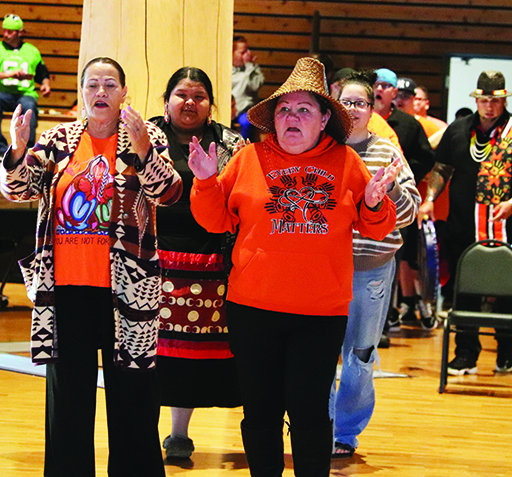
“And they were penalized for speaking their languages and practicing their cultural ways. Children were separated from their families for long periods. In addition to cultural genocide, residential schools are also the sites of the horrific physical, sexual, and emotional abuse perpetrated against these children. Through all of it – the violence and abuse, our culture is still here and very strong.”
Over the past several years, Tulalip has participated in Orange Shirt Day and helped open up discussion on a difficult subject matter. Though local boarding school survivors are exposing scars that they’ve attempted to keep hidden for decades, these yearly gatherings have become a safe space where they can talk about those dark times. And consequentially, they get to see a glimpse of their own resiliency and that the culture is alive and well in the 21st century. This work ultimately leads to a path of healing as the community embraces them and provides that good medicine through song and dance.
Tribal member and rez ball legend, Dale Jones, is known throughout the community for his sense of humor and his confident demeanor. During this gathering, he allowed himself to be vulnerable and share his experience with the people.
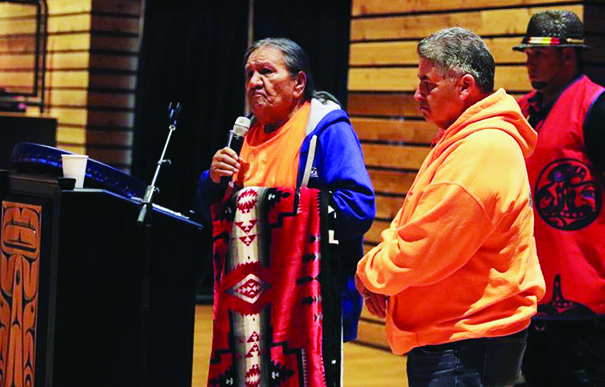
In a shaky voice, Dale shared, “I was about ten years old when they took me and three of my brothers and sent us down to Chemawa. It was a very hard life. They cut your hair, took away everything you had, and threw that white stuff on you to get rid of the lice. That was their excuse for doing that. And you could hear our brothers and sisters crying at night. It was very hard being ten years old and wondering if you’re ever going to go home. I buried myself in alcohol for years – because you bury that hurt deep within you. I gave it up about thirty years ago, cigarettes the same time.”
Upon arrival, the attendees received an orange t-shirt designed by Tulalip Artist, Walter Moses. Everywhere you looked, there was orange. It was beautiful to see so many people show up for the survivors. And also, for the children who were buried on residential school grounds across the country.
Said Ariel, “We call it Orange Shirt Day because of the story from Phyllis Webstad, a six-year-old girl who received a gift from her grandma. A brand-new orange shirt, which was then taken away on her first day at a boarding school. She stated that seeing the color orange would bring back memories. She went a long time without wearing orange. The boarding school gave her so much PTSD that seeing the color made her scared. We’re not only fighting for justice for her, but for the thousands who suffered their childhood at these so-called schools.”
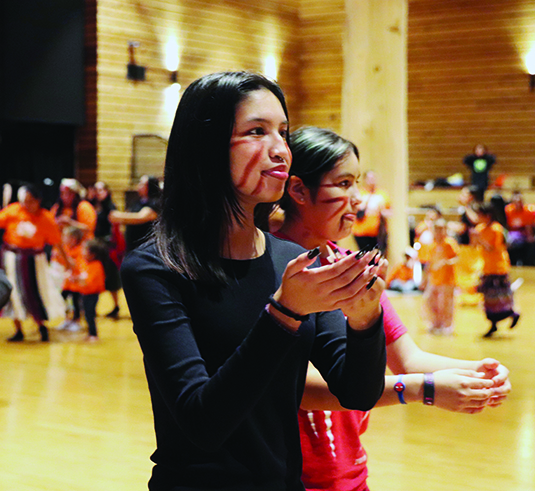
A slideshow made by Tulalip historian, Lita Sheldon, played on a loop throughout the night, which recognized all the youth who were sent to the Tulalip Indian Boarding School. Josh Fryberg was the emcee and as people trickled in, he helped get things started by calling upon Natosha Gobin for a prayer and introducing a music video dedicated to boarding school students, composed by Antone George (Lummi).
After the people shared a delicious dinner together, the drummers and singers were called to the front of the Gathering Hall. The event kicked off with the sduhubš Welcome Song.
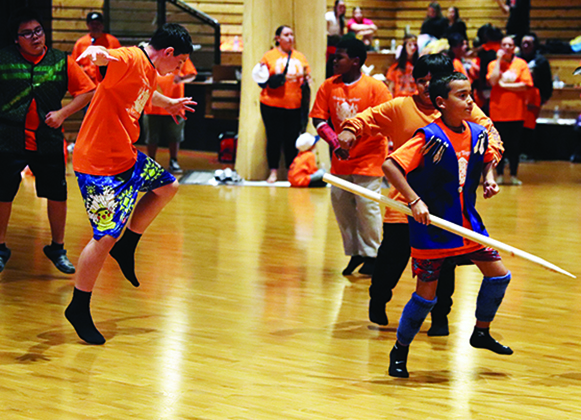
Tulalip Chairwoman, Teri Gobin, shared a few opening remarks, noting that the sduhubš Welcome Song is a testament to the government’s failed efforts at erasing the culture. During the reclamation of the Salmon Ceremony, the song was revived by boarding school survivor and Tulalip ancestor, Harriette Shelton-Dover. And ever since, the song has been a staple in modern day practices, serving as the opening song at many Tulalip gatherings.
In addition to the Valencia sisters and Dale, speakers for the gathering also included boarding school survivors Mel Williams Sr. and Matthew Warbonnet Jr. Both of these gentlemen spoke with heavy hearts as they recounted their years spent at boarding schools. All of the boarding school survivors were called to the floor and were seated at the center of the Gathering Hall. A number of seats were left unoccupied, in honor of the kids who never made it back to their families.
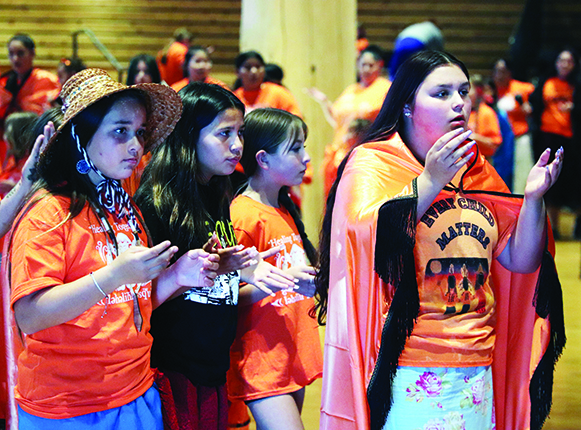
Mel shared, “I can still remember my first day when I went to residential school, after being taken away from my mom and our home. I remember getting there and one of the first things that they did, they put us on this chair, and they cut that long hair off. They told us we looked like savages with long hair like that. I remember getting dressed in different clothes that weren’t mine. And I looked around at the other boys and we were all dressed the same. I remember that evening, we had to shower. There were no ifs, ands, or buts about it. ‘You go and have that shower, and you clean yourself, you dirty Indian’. After the shower, we had to be inspected, and they inspected every part of our body. I didn’t like that fondling, and I showed it right away. So that person left me alone, only to prey on someone that was weaker than myself. Much of that went on in these residential schools, not with just the boys but the girls too.”
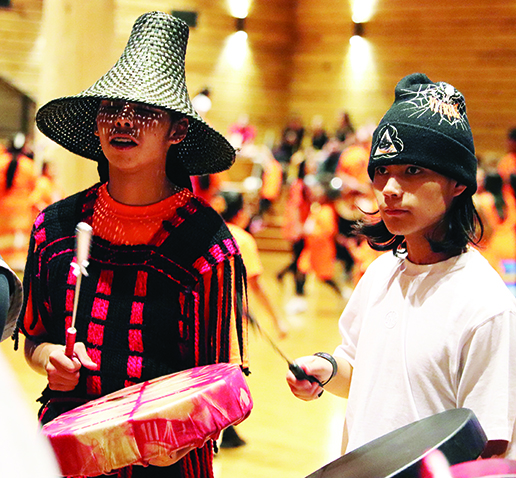
Chief Executive Officer of the National Native American Boarding School Healing Coalition, Deborah Parker, also shared some words. She stated, “I want to acknowledge the speakers before me who attended the residential boarding schools. When you tell your stories, it helps us to heal. When you share your truth, it helps tell a nation what you’ve been through. And we are all here for you. The children, the mothers, the aunties, the uncles, we’re here for you. We’re here for those names who didn’t come forward, for those children who never made it home. Nights like this, for remembrance, are critically important for those sitting in the chairs tonight and those who weren’t able to make it to these chairs.”
In a powerful moment, Josh asked everyone in the Hall to stand directly behind the survivors. He then instructed them to raise their hands in the air to send strength and love to the survivors. Tribal member, Tony Hatch then stepped to the front of the room and called the drummers and dancers to the floor once more. As Tony led them in a song, candles were passed out and lit. Tiny flames danced while the people raised their candles in remembrance of the young Native men and women who died at the hands of boarding school officials.
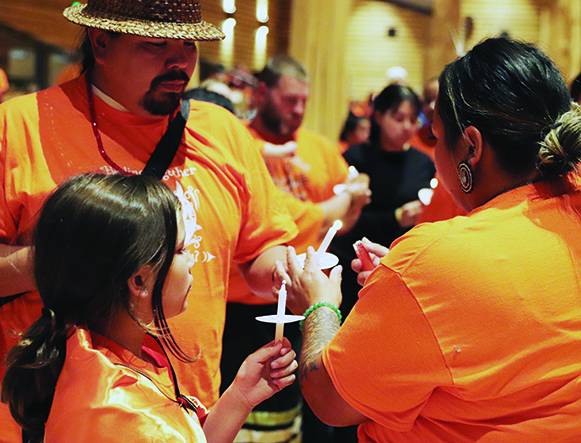
After a moment of silence and prayer, the first half of the event concluded. The coastal jam immediately followed and hundreds of community members, comprised mostly of Tribal youth, hit the floor to continue the night’s theme of ‘Healing Together’. The jam extended late into the evening and through traditional song and dance, the community spread medicine to the survivors, their descendants, and everyone affected by the trauma of residential boarding schools.
Deborah expressed, “When we see the children dance, remember there was a time when our children could not dance. And there was a time, even in my generation, where it was just the adults, and only a few children were on the dancefloor. And now, our children are leading the way. And someday those little children will be grandmothers and grandfathers, and they may not remember the pain, or the hurt, or the suffering that our relatives went through, but they’ll remember the joy and the happiness in these moments.”